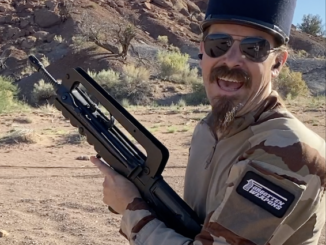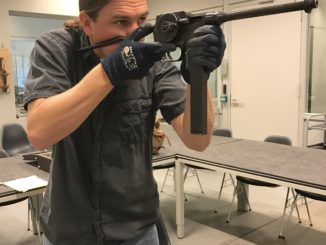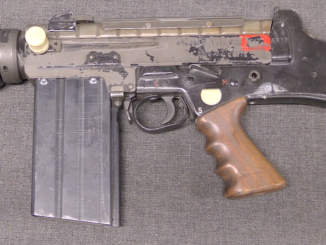France began working on developing military self-loading rifles virtually as soon as the 1886 Lebel was adopted, and they would pursue a pretty elaborate series of trials right up to World War I. One series was developed by Etienne Meunier at the Artillery Technical Section using gas operated mechanisms, and designated the A series. The B series was the work of M. Rossignol at the Musketry School, using mostly direct gas impingement systems. The C series was designed by Louis Chauchat and M. Sutter at the Puteaux Arsenal, and these were long-recoil actions. Trials commenced in 1911 and 1912 on the latest rifles from each series, and ultimately none was judged really ready for military service – although the A6 Meunier would be produced in small numbers (about a thousand) and issued in 1916.
This particular rifle is a C6, from Chauchat and Sutter. The C7 was in the formal testing, and this C6 is a very similar rifle. It uses a long recoil action, a unique locking system with two pivoting locking lugs somewhat similar to the Kjellman system, and a remarkably powerful 7mm rimless cartridge fed from 6-round Mannlicher type clips. It was deemed too complicated at trial, not surprisingly.




Rossignol is pronouced “Rossiñol”
A beautiful rifle beautifully complicated!
Thank you for this interesting video.
I know that at this time that self loading rifles were fairly uncharted waters, but you would think that some people would have a thought about using long recoil for a military rifle and say: hey, maybe having all this stuff getting flung around and all these very small parts aren’t such a good idea for an infantry rifle.
Maybe they wanted to go the Johnson route and just have the soldier turn it in for a thorough cleaning after giving the barrel a quick scrub?
Those dust covers are also pretty sweet and it always makes me wonder why Garand or the guys who designed the M14 didn’t incorporate sonething like that for a certain greasy track.
(RIP T25/47, we hardly knew your dust cover.)
V springs was a bad idea, very prone to snapping.
Interesting to find out about the B series with a gas tube, was this really the very first gas tube DGI ?
This C6 has used a magnum cartridge but then gone for tiny pivoting ( in comparison to a Mauser ) locking lugs, it looks pretty weak to me, I would be praying hard if I was firing it.
Do you expect the bolt to backfire into your face?
“DGI”
What DGI mean?
Direct gas impingement is what he said.
“remarkably powerful 7mm rimless cartridge”
Meunier self-loading rifle used 7×57 Meunier cartridge (not to be confused with 7×57 Mauser)
http://www.municion.org/7mm/7x57Meunier.htm
Meunier A6 M1916 rifle (France) query in Modern Firearms give its ballistic as 9 g @ 850 m/s giving 3250 J (and barrel length as 715 mm), this is quite close to 7×64 Brenneke (for example Norma gives data for 9.1 g bullet: 900 m/s but this might be for longer barrel and/or include progress in powder technology)
–
It seems that several countries before WWI want introduce 6…7mm rifle cartridge of high velocity, but does anybody tries to make machine gun for it?
The US Navy and Marine Corps used the https://en.wikipedia.org/wiki/M1895_Colt%E2%80%93Browning_machine_gun in 6mm Lee Navy in the 1890-pre 1907ish
https://en.wikipedia.org/wiki/6mm_Lee_Navy
military loading 112gr (7.3g) 2,560 ft/s (780 m/s) 1,629 ft·lbf (2,209 J)
Initial loading 135-grain (8.7 g) 2,550 fps (777 m/s)
Looks like whoever designed the rear site had a good look at an original German M98 Lang rear site.
Cool rifle, but much more complicated than the ww1 era RSC1917.
I hope, Ian, you will be able to shoot your RSC sooner or later!
Thanks for sharing.
“ww1”
Notice that one expect this war to last 4 year.
Wilhelm II said:
You will be home before the leaves fall from the trees.
to soldiers in August 1914.
All expected that war will be fought with produced supplies/weapon, but after it turns to be stalemate, simple design which can be widely produced, become much demanded.
Looking at the internals of this rifle and of the Puteaux 1905 (St. Etienne 1907) machine gun, it seems that the designers there were more interested in clocks than firearms. ^__^
Looking at 4th image from top here:
http://world.guns.ru/machine/fr/stetienne-m1907-e.html
I feel that they want as steampunk (or Victorian Science Fiction?) machine gun as possible.
As surprising as it sounds, it worked quite well ! Well, at least it worked… Vaguely. Almost. Sometimes.
Would the mystery lever
I try again (dam you iPad). Since it interferes with the follower, would the “mystery lever” on the right hand side of the gun at 22:40 be a way to close the bolt with out chamering a round?
The Rube Goldberg machine from hell !
Sutter usually did simple and effective things but this day he surely was on cocain…
Cocaine, the same drug to which Sherlock Holmes was addicted and to which Dr. Watson strongly objected. Are you sure Sutter injected himself before getting on the drawing board? Crack cocaine didn’t exist yet…
Well, I don’t know if Sutter used cocaine on any form, it’s just a French expression to say “to be on a particularly serious state”. This day, Sutter was in a particularly serious state of overcomplicated mind.
Mystery lever…. looks like a way to push the follower out of the way and close the bolt with no clip in the magazine
I see that in the great tradition of French military rifles, they decided that safety catches were for wimps.